Por Ellen Nemitz · ECO - 18 de dezembro de 2024 - Câmara ressuscitou “jabutis” da…
The Collapse of Global Civilization Has Begun
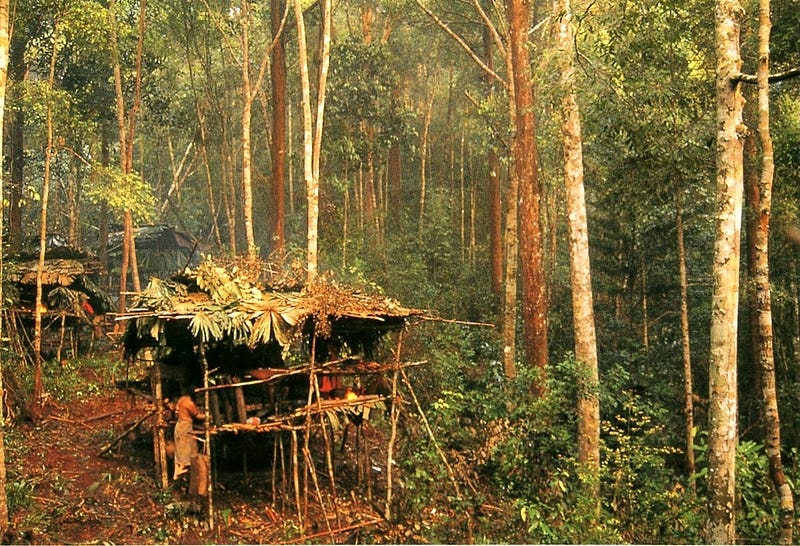 A temporary settlement of the Penan, Borneo 1993 © David Hiser
A temporary settlement of the Penan, Borneo 1993 © David Hiser
But this doesn’t mean we have to give up hope.
Only the fewest today think that global civilization is on the brink of collapse — but it’s doubtful that the Romans, the Greek, the Mayans or the Mesopotamians saw their own fall coming either. We hear about new obstacles on a daily basis; most of the news consist of disturbing stories on increasingly overwhelming issues that, plainly spoken, seem impossible to solve. And yet, no one even recognizes that it is collapse that starts to unfold all around us.
Civilizations are characterized by the emergence and expansion of cities, as the Latin root of the word suggests (lat.: “civis” = inhabitant of a city), that, in some instances, turn into states. A city is a permanent settlement of humans where more humans live than their immediate environment can support. Therefore, the city requires the import of food and other resources from the surrounding area. The use of the term ‘require’ hereby implies that if the rural population doesn’t agree on exporting the product of their work, the city comes and forcefully takes it (Scott, 2017; Jensen, 2006). The city continuously expands as its population grows, requiring evermore resources from the rural surrounding, and therefore depleting an ever-increasing radius of land. Civilizations can, by definition, not be sustainable, since every expansion on a finite planet logically has a limit — and “colonizing other planets” is obviously nothing but science fiction. Earlier civilizations reached this limit after a few hundred or thousand years, but with the advancement of technology we repeatedly found loopholes that allow us to artificially modify conditions in our favor. As we slowly reach the limit of technological, physical and biological possibilities to further expand as a civilization, it is of utmost importance to understand what is happening and why.
If we can learn one thing of the past collapses of major civilizations, it is that all of those showed some (if not most) of the following symptoms during or immediately before their imminent collapse: environmental destruction, depletion of vital resources (such as water, arable soil and timber), famine, overpopulation, social and political unrest, inequality, invasion or other forms of devastating warfare, and disease.
Think for a second. I guess you will be able to come up with a current example for each of the points listed above in under a minute. If not, here are a few examples:
***
Environmental destruction
Virtually every environmental crisis ever recognized as such in the last century has since worsened. All goals set by the Earth Summit in Rio De Janeiro (1992), its follow-up Rio+20 (2012), the Kyoto Protocol (1997), the Copenhagen Agreement COP15 (2009), and the Paris Agreement (2016) have failed to make a considerable difference.
At the latter event, politicians agreed that climate breakdown must be mitigated, and half-hearted promises were made to set utopian goals for a reduction in CO2 emissions.
No matter what you look at, may it be deforestation, atmospheric carbon levels, species extinctions, polluted rivers, every aspect has gotten worse year after year. Governments doesn’t seem to be able to solve this crisis, and neither is the public. Recently the Global Carbon Project announced that, despite all the efforts and the fact that overall carbon emissions from fossil fuels and industry have experienced only “flat growth” over the last two years (a sign of hope for many), the carbon emissions will once again grow by 2% in 2017 — and the trend is expected to continue next year.
It seems like all our efforts are destined to fail.
Forests all over the world continue to be destroyed in the name of economic growth, progress and development, and we civilized humans set in motion what some call the Sixth Mass Extinction Event. In the past 40 years, we lost half of the world’s wildlife, and species extinctions proceed at an unprecedented rate — estimated at 10,000 species per year (WWF), or about one species per hour.
Simultaneously, the decrease of insect populations across Europe by over 70%, already bearing the label Insectageddon, is believed to have disastrous impacts on human crops and ecosystem stability in the coming decade.
We logged over 75% of all forests in the 10,000-year history of our culture, and logging continues at breathtaking speed (currently deforestationproceeds at a rate of 48 football fields per minute, while we concomitantly lose 30 football fields of topsoil per minute).
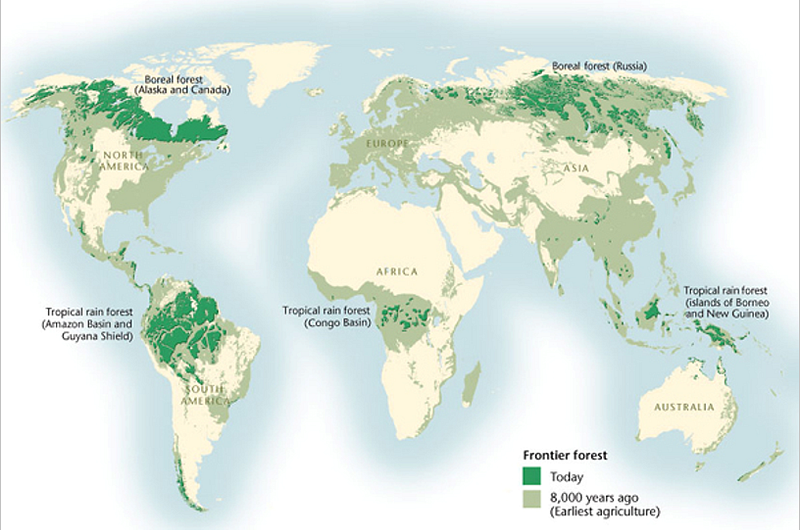 © National Geographic
© National Geographic
Pollution & extreme weather events
The CO2 concentration in the atmosphere has skyrocketed to 400ppm (the highest in over 800,000 years), and the emissions from today will stay there for another century.
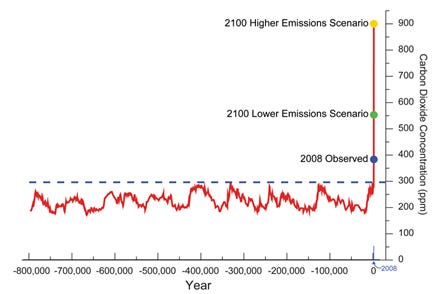
Despite extensive lobbying, it is now known that the biggest 15 ships produce as much pollutionas all the cars in the world. They burn the dirtiest of all fuels, and have to pay surprisingly low taxes for it. But nothing that we do pumps carbon dioxide into the atmosphere faster than air travel, yet new airports are build and existing ones extended, and the number of airplanes in the sky on any given day continues to rise.
The world’s hunger for oil and the companies’ increasing difficulty to meet the demands by conventional means have created over one trillion liters (!) of highly toxic sludge from tar sand processing in Canada. Those ponds cover an area of over 220 km2 — as big as 73 Central Park’s.
But those are not the only extremely hazardous black lakes there are — a giant lake filled with thick, black sludge in China was recently dubbed “the worst place in the world”. It is a result of our worrying dependency on smartphones: in inner Mongolia, the ‘rare earth’ minerals needed to build them are processed, and the vast amounts of biohazardous and radioactive waste is discharged arbitrarily into the landscape right next to the factories.
Even if the industry would disappear tomorrow, their carcinogenic waste would stay with us for centuries, polluting skies, rivers and soil.
Microplastics are found not only in the oceans, but in alarming quantities in most tap water all around the world. They even made it into the atmosphere, making it literally impossible to escape the plastic particles small enough to enter the cells of your body, where their toxicity increases the chance of cancer and other diseases.
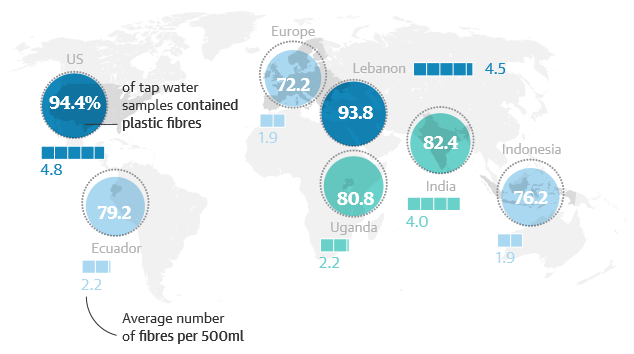 © Guardian — Tap water everywhere contains large amounts of plastic fibres
© Guardian — Tap water everywhere contains large amounts of plastic fibres
All those problems will, due to climate breakdown, only get worse in the future (Lynas, 2009). Positive feedback systems now lead to unstoppable changes on the surface of the planet. Rapidly melting ice caps mixed with increased air pollution leaves a dark layer of dirt on the surface, enhancing further warming and melting of the ice. Forest fires all around the world contribute to an ever-hotter climate, which in turn leads to even bigger, more devastating forest fires.
Petteri Taalas, secretary general of the World Meteorological Organization, said: “The past three years have all been in the top three years in terms of temperature records. This is part of a long term warming trend. We have witnessed extraordinary weather, including temperatures topping 50C in Asia, record-breaking hurricanes in rapid succession in the Caribbean and Atlantic reaching as far as Ireland, devastating monsoon flooding affecting many millions of people and a relentless drought in East Africa.”
Sea levels have already risen considerably, and even the most pessimistic forecasts have proven to be true. In his 2006 documentary An Inconvenient Truth, Al Gore claimed that sea level rise will flood the 911 memorial — at that time ridiculed — which actually happened during hurricane Sandy.
Hurricanes increase in intensity every year, leaving behind post-apocalyptic landscapes like seen in the Dominican Republic and Puerto Rico after hurricane Maria.
Resources
Resources such as oil, phosphorus, antimony, indium, silver, copper, sand, and others long have peaked, hence officials do what they can to ensure the public that everything is alright and no problems are ahead — it would cost them their jobs and render their occupations superfluous if they said the truth.
The only “official” numbers on how much oil remains are presented annually by — you guessed it — BP. Not very convincing. Those numbers are presented in confusing fashion, since BP’s calculations are based on “current consumption levels”. But guess what, consumption is increasing, and despite so-called renewable energies having a small share of the overall energy created, our world still relies heavily on fossil fuels. This is not going to change anytime soon.
If you do the same calculation with the average growth rate in oil consumption, you’ll end up at a date somewhat 15 years earlier (2052). And remember: this is only if all discovered oil fields can successfully be exploited, whether they are under the Arctic ice shield or in the Ecuadorian Amazon rainforest. Furthermore, this is supposed to be the day where we arrive at zero barrels of crude oil, so scarcity will start much sooner.
For years they have been pushing back the date of when exactly the world will run out of oil, because they constantly seem to find new reserves. Even if that might be the case, it is worth noting that those newly discovered oil fields are in the most inaccessible places, since all the fields that are easily exploited are already empty. Those new oil reserves require increasingly dangerous, expensive and destructive technology: offshore drilling, fracking, and the extraction of oil from tar sands.
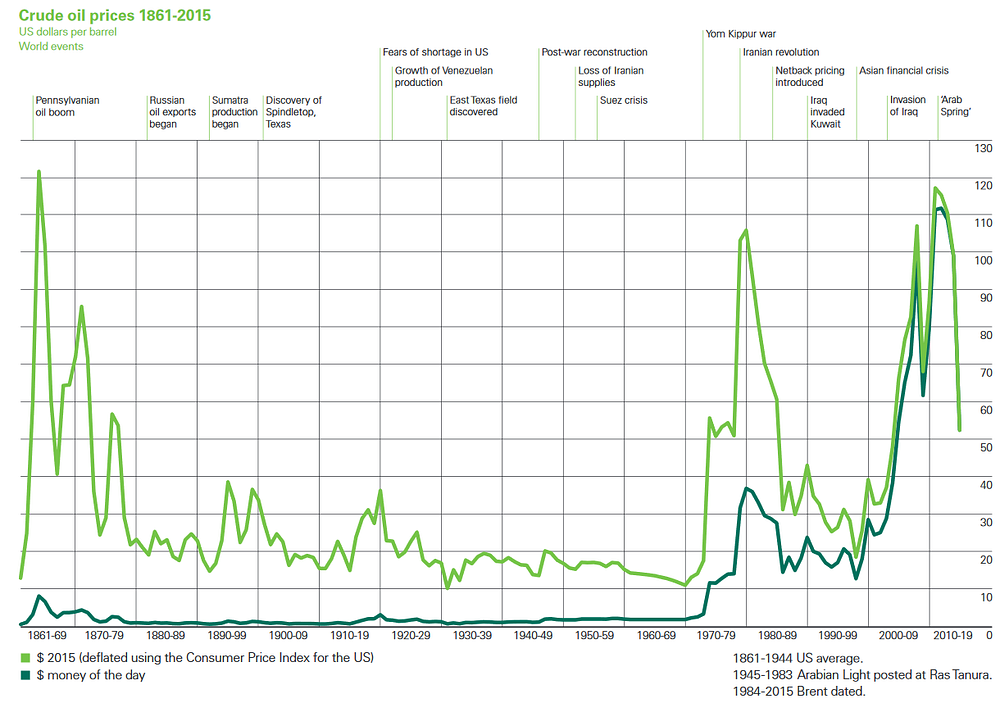 © BP — Will the oil price really continue to drop? What justifies this sharp decline, and how does it fit into the context of a world slowly but surely running out of oil?
© BP — Will the oil price really continue to drop? What justifies this sharp decline, and how does it fit into the context of a world slowly but surely running out of oil?
While the question of how much oil there is really left leaves room for speculation, I recommend looking at the graphs yourself.
War over resources are supposed to increase, and it is even the most basic resources that inspire conflict. With the Tibetan glaciers melting, China, India, and all countries around the Mekong River can expect serious water shortages in a few years. In China alone, over 28.000 rivers have dried up already, according to the Ministry of Water Resources.
All in all, an estimated 2 billion (!) people are in danger.
“Many experts say that wars were fought over land before, but nowadays, wars are fought over energy and soon there will be wars fought over water,” said Lobsang Sangay, the head of the Tibetan Administration in Exile.
Famine
At a time where even pro-business and pro-development Forbes Magazine writes that “Capitalism Will Starve Humanity Until 2050” (unless it “changes” — whatever that means — but this big change is yet to come), it should be clear that we’re very close to the total collapse of global food supply. In the article, the only problem addressed is overfishing of the oceans (not even the ongoing acidification or pollution is included).
A sophisticated simulation called ‘Food Chain Reaction’ was built by experts of the State Department, the World Bank, and multinational agrobusiness giant Cargill, along with other independent researchers and specialists. It involved the participation of 65 officials from countries all over the world, as well as key multilateral and intergovernmental institutions.
“By 2024, the scenario saw global food prices spike by as much as 395 percent due to prolonged crop failures in key food basket regions, driven largely by climate change, oil price spikes, and confused responses from the international community.”
The importance of this simulation lays in the fact that it was created partly by powerful organizations, who would lie to the public but not to themselves — as it was the case with Big Oil publicly denying climate breakdown, but internally preparing for its effects. They might tell the public that we have another 40 years or so worth of oil in the ground, but they themselves know that 2024 would be a much closer call for either scenario.
Now, remember, all those factors examined here are interrelated. No oil means consequently no food in the supermarkets. You can imagine what would happen.
According to reports by a government contractor, “the US national security industry already plans for the impact of an unprecedented global food crisis lasting as long as a decade.”
Overpopulation
The world is, in contrast what humanists and futurists might say, vastly overpopulated (Their error is to think the planet is empty and just waiting to be filled up with humans). That means we have exceeded the carrying capacity of this planet by several billion people. There is no way that such number of people could ever live in a sustainable relationship with their environment.
More than half of the world’s population now lives in cities, in some cases in apartments so small that they are called ‘coffin homes’.
The numbers are staggering: “The built world that sustains us is so vast that, for every pound of an average person’s body, there are 30 tons of infrastructure: roads, houses, sidewalks, utility grids, intensively farmed soil, and so forth”, says Jedediah Purdy, author of After Nature: A Politics for the Anthropocene. Without this enormous construct to sustain our current population levels, we would fall back somewhere between ten and two hundred million. If anything would happen to any part of the infrastructure listed above, the consequences would be severe.
When we talk about overpopulation, we also have to include the fact that domestic animals for human use outweigh wild terrestrial mammals by a factor of 25 to one. Civilized humans come with a lot of luggage.
Social and political unrest
Saying that society falls apart is no longer an exaggeration. Every day there are huge protests and clashes with the police all around the world. The public is divided into ever more fractions that are unable to come to any compromise. Whether left or right, conservative or liberal, pro- or anti gun, refugee, abortion, vaccines, or climate change, the two opposing fractions are doing nothing but hardening their own hearts against the other side. They are trapped in echo chambers on social media that only confirm what they already believe to know, and therefore intensifies their conviction of their own righteousness.
This year alone, there were over 50,000 (!) recorded incidents of gun violence in the United States — 307 of which were mass shootings.
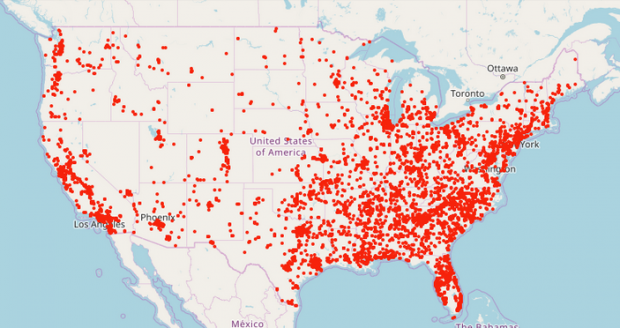 © Gun Violence Achieve
© Gun Violence Achieve
Radical groups, sometimes militarized, are on the rise all over the planet. Whether patriot groups in the US, FARC in Colombia, pirates at the coast of Somalia, ISIS in the Philippines, Boko Haram in Nigeria, or underground right-wing terror cells in Europe, everyone seems to prepare for some final war.
Technology, once viewed almost exclusively in positive terms, encounters more and more skepticism as Big Tech tightens its grip around our personal lives. A large number of people in the developed world is seriously addicted to smartphones — no wonder, since they are in turn specifically designed to make us addicted. More studies emerge every week showing the huge downside of advanced technology, that most of us so far have simply overlooked. The effects of our highly technologized society on our childrenare spine-chilling — and its consequences even more.
Managers, CEOs, bankers, politicians and other members of the upper class systematically avoid paying taxes, therefore robbing the public of money that is desperately needed in the communities. The leak of millions of documents, called the Panama- and Paradise Papers shows the sheer scale of this peerless fraud. A global plutocracy has reached unimaginable power. Oligopolies control the economy, politics and society. Dystopia is here.
On an international level, democracy doesn’t seem to work anymore. With the emergence of more and more authoritarian leaders such as Trump, Putin, Erdogan, Chan-Ocha, Duterte, and Órban, the world slowly starts shifting towards an uncertain future.
Politics has always been a dirty business. But in the digital age it gets increasingly hard for politicians to hide their wrongdoings and corruption. Without portable cameras in everyone’s pocket and all information being stored online it is impossible to hide things as long as governments used to do back in the days — until everyone involved was beyond the reach of persecution: retired or dead.
How many times have we witnessed governments change from liberal, to conservative, and to liberal again, all ruled for by people who really believed that this election will finally set things straight. It is unbelievable to me that people still fall for this.
Economic collapse is imminent, not only because of all the bubbles yet to burst (like the debt bubble, the student-loan bubble, the tech bubble, or the giant real estate bubble that caused China’s double-digit growth and led to vast half-finished ghost towns for millions of inhabitants — China used more cement in three years than the US in the entire 20th century for those projects, which in turn is one of the reason the world is running out of sand), but simply because economic growth is reaching its absolute limit.
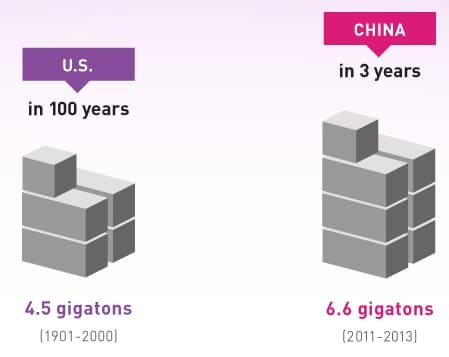 © Bill Gate’s Gatesblog
© Bill Gate’s Gatesblog
We are trapped in a dilemma: we collectively decided that we “need” economic growth, yet economic growth destroys the planet and continues to deprive us of the last freedoms and resources. There is no logical approach to solving this fundamental crisis that undermines even the most basic assumptions about ourselves and our place in this world. If our economy is not growing anymore, what else is there to do? If, after all the cumulative effort, the contraption we’ve built will collapse in on itself anyway, where’s the point? Good question.
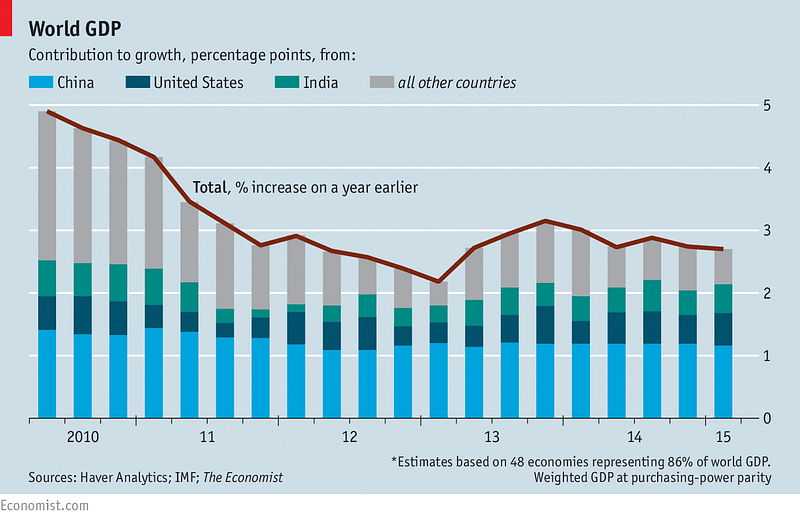 © The Economist — The world economy seems to stagger.
© The Economist — The world economy seems to stagger.
Inequality
Global inequality is worse than ever — and probably even worse than that. Poverty is a trap, and being rich literally pays off. Banks take money from those in debt (the poorer you are the more you have to pay), and pay money to bigwigs, who receive more money the richer they are. 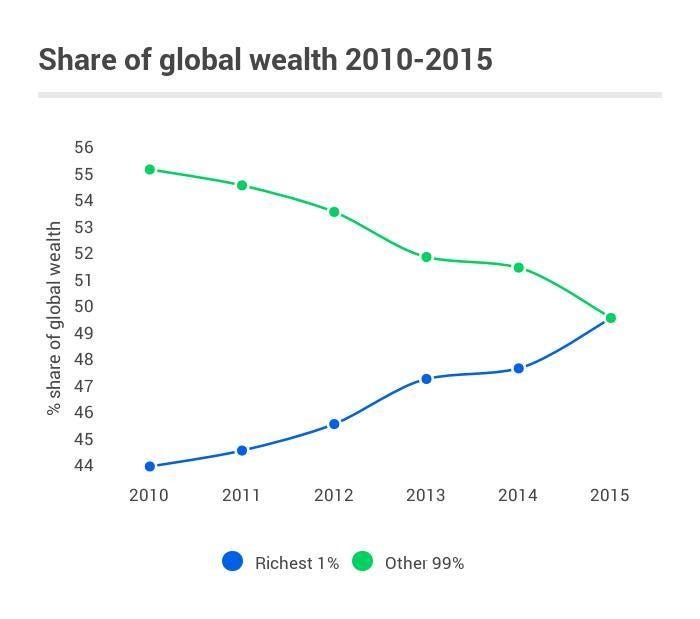 © World Economic Forum — The richest 1% now own more wealth than the remaining 99%.
© World Economic Forum — The richest 1% now own more wealth than the remaining 99%.
The many other gaps between men and women, black and white, East and West, developed and developing are nowhere near closed as well.
Warfare
With the erratic Donald Trump as president of the United States, and Putin, who wants to keep up with the United States renewal of their nuclear arsenal, a nuclear arms race has once again started that was already called a Cold War 2.0.
With North Korea shooting missile after missile in Japan’s direction and sending threat after threat over the pacific for fear of their own nation’s continued existence, nuclear war has become a real possibility.
The climate between Pakistan and India (both nuclear powers) is as tense as ever, with India showing increasing concern about possible conflict with China in the future, too. China is involved in an ongoing genocide in Myanmar, for the sake of building a pipeline through the country to supply China with oil.
Israel still doesn’t let anyone inspect their nuclear weapons arsenal and their increasingly fascist government is a ticking timebomb in the Middle East.
The infamous ‘Doomsday Clock’ is again at two and a half minutes to midnight — the closest since 1953.
The Islamic State of Iraq and Syria might have been defeated on the ground, but the ideas and the hate will sure stay, inspiring new jihadi movements to sprout up. In a vicious cycle of violence, terrorist attacks in the West are answered with bombing campaigns, which in turn fuel the propaganda of radical Islam.
Warfare itself changes, too. There is a tendency towards automation, and digital warfare is an increasingly real threat.
Drones are used on a regular basis against weaker countries, even though they cause more civilian deaths than regular battles. It is just very convenient to randomly fire missiles into crowds of alleged terrorists from eight kilometers above.
Combat robots are developed and tested by armies all around the world.
Ever more powerful weapon technologies are being built despite international agreements on their ban — and used, as seen with the sarin gas attack in Syria and the ‘Mother of all Bombs’ dropped on a mountainside in Afghanistan by the Trump administration.
Disease
Public health isn’t increasing either, and pollution might be the number one reason — pollution now kills more people than smoking, hunger, natural disasters, war, murder, AIDS, tuberculosis and malaria together. While we continue to destroy Nature, this very act unleashes more diseases.
With the advancement of globalization, and despite popular opinion, global health continues to decline.
The nutritional value of our food is at a historic low, vital phytonutrients have virtually disappeared from our daily meals, industrial sugar in almost every processed food poisons generations, and biodiversity declines as a direct result of conventional agriculture. We, as a society, are “overfed but undernourished” — for the first time in human history there are now more over- than underweight people in the world.
The air in New Delhi, a city with a population of 26 million people, has reach a toxicity equal to smoking 50 cigarettes per day. The most polluted cities on earth are almost exclusively located in India, China and Saudi Arabia.
This is not because Western countries are cleaner, it is because they simple export their own pollution.
There seems no way out of the opioid crisis in the US — Big Pharma lobbied doctors and lawmakers into easily prescribing them, getting millions of people addicted, and now, as the Trump administration cracks down on painkillers, those people are forced into use of heroin and fentanyl.
The World Health Organization and numerous other experts have continuously warned of the disastrous consequences of a post-antibiotic world, where even the smallest infection might end deadly and surgery is not an option anymore. Yet no one can think of a way to reduce antibiotic prescriptions by doctors or the use of antibiotics in factory farming. Antibiotic-resistant “superbugs”, who will most likely kill millions in the next decades, emerge on a worrying scale in China, India, and even in the Western world.
***
Everyone, this is how collapse looks like. It may take years or even decades, but we have already set it in motion. We are at the beginning of a gradual downwards spiral, that accelerates as it spins on into the abyss. Watch it slowly unfold over the next few years, and better make plans for what you will do — because many members of the upper-class elites who know and understand the world on a global level are already making emergency plansfor the coming cataclysm.
You see, I am by far not the only one who thinks like this (there are Theodore Kaczynski, Paul Kingsnorth, Derrick Jensen, Edward Abbey, and John Zerzan, just to name a few more popular advocates), nor the first one to point this out (just think about Thomas Malthus, who warned of collapse in 1826).
A NASA-funded study focusing on only two issues concluded that “Two important features seem to appear across societies that have collapsed. […] The stretching of resources due to the strain placed on the ecological carrying capacity and the economic stratification of society into Elites and Masses.” According to the researchers, “collapse is difficult to avoid. […] Elites grow and consume too much, resulting in a famine among Commoners that eventually causes the collapse of society.”
From collapses of past societies we now know that in most cases, there is not one single factor that we can attribute this collapse to, but rather a series of interrelated events (Scott, 2017).
Our globalized society shows not only some, but all of the factors that led to collapse of past civilizations, and through the use of advanced technology we have been able to create conditions worse than any other civilization ever had to endure. Some might think, “Well, if technology has brought us so far, it will sure bring us further”, and they might even be right — but only for the next few years. It is obvious that the techno-industrial system can’t continue to try to fix occurring issues forever. There are simply not enough resources left. Like the Roman Empire when it began to decline, we’re in a period of overshoot, that will inevitably be followed by collapse (Tainter, 1988). Time is running out.
In the past, when a civilization was in the process of collapsing, other surrounding societies could take advantage of their vulnerability, and sometimes merge the remains with their own empire. This is not an option anymore in times of global interdependency on international trade and transportation. If one goes down, the others follow. The Domino Theory of collapse.
It is also impossible to recreate our civilization, since we already burned all the fossil fuels needed for the technological advancements that allow a global civilization to temporary sustain itself.
Fantasies of “colonizing the universe” are not helping us either — we humans evolved over millions of years to fit exactly into the conditions found here on Earth — this atmosphere, this temperature, this chemical composition of solids, liquids and gasses, this gravity, this UV intensity — and it is absurd to think that we could create a functioning ecosystem on an entirely different planet all by ourselves in a matter of decades. Even the most ambitious plans for colonizing Mars will fail because of resource depletion and any given combination of all factors leading to collapse listed above. If, against all odds, anyone gets to “escape” Earth, it will not be you, anyway — it will be the one that pays the most.
Free energy is nowhere around the corner, neither is truly sustainable energy. Solar panels are made from sand, which is running out. The production of photovoltaic plates for solar panels requires tremendous amounts of energy, involves the excessive use of highly toxic chemicals and creates vast amounts of waste products such as silicon tetrachloride (three to four tons of which are produced for every ton of the desired polysilicon), which forms hydrochloric acid upon contact with water, is often casually dumped somewhere and already devastated landscapes in China.
Constructing dams kills river ecosystems and creates one billion (!) tons of greenhouse gasses a year. Wind turbines are producing millions of tons of trash and kill birds, bats and insects.
Furthermore, all of the above technologies depend on the same old, dirtysystem of mining, transporting, smelting, refining, shipping, assembling, manufacturing, distributing and constructing.
The only sustainable form of energy on this planet comes in form of calories.
You might call me a pessimist now, but I don’t think you would find enough positive news to outweigh the above. This is not pessimism, this is what actually happens.
Neither is this alarmism. The only alarming thing is that there are people blind enough to think that everything will work out just fine, as long as we just recycle, invest more money in solar companies, drink fair-trade coffee, buy a brand-new Tesla, or drive a bicycle to work.
Politicians continue to ensure us that “the best days are yet to come”, yet most of us feel the opposite — it is the worst days that are yet to come. And worse those days will be. As with earlier collapses, the aftermath must be horrifying. But would it be really that bad?
I’ve heard people calling the announcement of collapse ‘elitist’, since, according to the logic they apply, you automatically approve of millions — if not billions — of people dying. They hold the unquestioned assumption that it will be “the others” who will suffer the most, which is true — but only as long as civilization exists and continues to suppress and exploit them. Millions, maybe billions, will die anyway if this system continues to wreak havoc on this planet.
Actually, it will be the global elite which will be hit the worst: the urban populations of the Western world with no knowledge of basic survival or the ecosystem around their cities.
The global rural poor might actually be better off without the capitalist system stealing their land or exploiting and enslaving them. Consider the words of Anuradha Mittal, former co-director of Food First, who said that former granaries of India now export dog food and tulips to Europe. Same goes for many of the urban poor, who live in slums not by choice but because they were forced to relocate, thanks to the actions of multinational corporations and banks — they still have the knowledge of how to live a life as subsistence farmer.
The ones hit hardest by global collapse will be those in the highest ranks of our civilizations’ hierarchy.
Feeling hopeless yet? Despite the overwhelming horror all this might induce at first, there is no need for nihilism and despair.
***
A New Hope
But not all is lost — as presented by James C. Scott and Joseph Tainter, the “Dark Ages” following previous collapses were often a time were personal freedom flourished, and repressive systems were replaced by community efforts to support each other.
Civilized culture might not have any plans for the event of collapse of infrastructure, trade, industry and medicinal and food supply. Most people imagine some kind of post-apocalyptic ‘Mad Max’ scenario where the ones with the most guns rule and a more primitive but still civilized lifestyle emerges that brings back the horrors of our own civilized past — famine, plague, slavery, and the “law of the strongest” (sometimes falsely called “the law of the jungle”). This nightmarish tale was the inspiration for a number of Hollywood movies that further put focus on the alleged inevitability of some chaotic, violent future for humanity (Think about “The Book of Eli”, “World War Z”, “12 Monkeys”, “I Am Legend”, “The Day After Tomorrow”, “The Matrix”, “Oblivion”, “28 Days Later” and even kids’ movies like “WALL-E”). As a response to those nightmarish scenarios, some buy ammunition and canned food in anticipation of the cataclysm — but when the last bullet is fired and the last can of beans emptied, they are back at exactly the point where they started.
This vision of the future is indeed terrifying, since after all it is a very likely scenario — even though most people would prefer to have some alternative.
What we lack is an idea of what to do, a short- and long-term plan for when things go south. We seem to have all the knowledge in the world, but yet we lack the simple knowledge of how to live.
But you can call of the search and cancel the think tank meetings: There already is a truly sustainable lifestyle, proven successful for three million years and counting and custom-tailored for us humans by the indisputable power of evolution: tribalism.
Evolution came up with a social organization for every animal, carefully selected through trial and error until reaching the optimum. It organized whales in pods, baboons in troops, wolves in packs, buffalo in herds, birds in flocks, ants in colonies, bees in hives, school in fish — and humans in tribes. There is a way for every single animal that works for this animal within the limits of its ecological niche (and therefore for all the other animals inhabiting this niche, too).
Who are we to think that after only a few thousand years we came up with something better, more successful?! There was no rational impulse to carefully construct something considering any possible limits and boundaries, people just started building like fury! The one big long-term study on whether civilizations are sustainable enough to successfully replace tribalism will soon come to a final conclusion: No.
We have to get off our high horse and come in contact with the Earth once again. We have to realize the huge mistake we made, the “worst mistake in the history of the human race”, as anthropologist and best-selling author Jared Diamond called it. We have to remember the “original affluent society”, as another anthropologist, Marshall Sahlins, famously wrote.
 The original affluent society: Members of the Penan tribe eat in their hut. Borneo, 1993 © David Hiser
The original affluent society: Members of the Penan tribe eat in their hut. Borneo, 1993 © David Hiser
Most modern-day anthropologists are already united in the ability to see through the racial bias of earlier times, and come to surprisingly positive conclusions about the exact same people that were considered “savages” whose lives were “nasty, brutish and short” in times of colonialization. They see people who are peaceful, content, and happy, who carefully consider their actions, avoid confrontation, and have no significant impact on their environment. If you think I am perpetuating the “Noble Savage Myth”, just watch a documentary about any primitive tribe, or read a book by someone who experienced their life first hand.
Without even one exception, all of the problems listed in the first part of this essay are directly motivated by and justified with the unquestioned assumption that we humans can do with this world as we please — we can destroy, improve, relocate, build, dam up, extract, cut down, construct, dig out, burn, and dump as much as we want, like gods, shaping the world to fit our desires. This misbelief, called anthropocentrism, is what caused all those terrible things in the first place.
The underlying theme of our own culture’s mythology was formulated by Daniel Quinn as follows: “The world was made for man, and man was made to conquer and rule it.” We have lived by those words until now, and it almost killed us. It has shattered this once beautiful and thriving planet into pieces, dust and trash.
But this is no inherently human belief. It is the belief of only one single culture. A culture that rose from the first agrarian settlements to a globalized techno-industrial civilization.
 An intruder killed for trespassing on the territory of the Tagaeri tribe, once part of the Huaorani (Ecuador), who crossed the border of their land. The Tagaeri’s lives are under constant threat by missionaries and illegal loggers, poachers and gold miners, who often bring disease and violence.
An intruder killed for trespassing on the territory of the Tagaeri tribe, once part of the Huaorani (Ecuador), who crossed the border of their land. The Tagaeri’s lives are under constant threat by missionaries and illegal loggers, poachers and gold miners, who often bring disease and violence.
As you may have noticed, I purposely avoided to make general claims about humanity, and therefore used terms like “civilized humans” in my argumentation. I did this to stress the fact that ‘we’ do not represent humanity (Quinn, 1996). There is nothing wrong with humans as a species. For 99% or our species’ time on this planet, we have been nomadic hunter-gatherers, and this most successful of all lifestyles continues to this day, where dozens of uncontacted tribes make it clear that they are not interested in the development our civilization has to offer in exchange for their home, the forest.
Those primitive people, as long as they are left alone by the people of our culture and live in “voluntary isolation”, are living proof that the lifestyle does still work — so good in fact that it is worth defending with their very lives. And there is more: primitive life doesn’t only work for humans (who enjoy a varied organic diet and therefore superior health, ample leisure time and low levels of stress because of a lifestyle characterized by play), it works for other animals, as well as plants, rivers, and mountains.
Some may now claim that I “romanticize the past”, but this accusation is usually made by people who think it is more ‘grown up’ to romanticize the future.
Don’t get me wrong! I am not proposing to “go back to the Stone Age” (which of course is physically impossible), nor do I want everyone to become a hunter-gatherer. But there is a lot we can learn from those (ab)original people, because they have the most important knowledge of all, the knowledge that we lack: they know how to live, without devastating their environment on which we depend for our very survival.
 Araweté woman playing with butterflies. From: ‘The River is Life’ © Alice Kohler
Araweté woman playing with butterflies. From: ‘The River is Life’ © Alice KohlerI do advocate self-sufficiency, autonomy, independence, simplification, localization and rewilding. Knowing the plants around you, the movement of the mammals and the language of birds. Reading Nature’s signs, predicting the weather and listening to the wind in the leaves. Doing things yourself and not relying on people you don’t know. Feeding yourself, planting trees, building your own house, creating and nurturing a community and caring about the people you love. Carving a flute and mastering it. Reading and educating yourself and others. Playing games and laughing. Drinking tea when it’s cold and taking a bath when it’s hot.
I advocate trying to do everything yourself, from materials that you yourself collected and processed. I advocate quitting your job, going back to the countryside, breathing the fresh air, feeling the sun on your skin, and letting go. Breaking out of the cage. Being as free as you can.
I cannot provide you with a final solution to all of our problems, but I can tell you were to look for answers to those problems. I say we make the best of our situation, we embrace collapse, and use the opportunity to create something better — something that works. The possibilities are endless.
I have looked for answers, and I found many of them answered by simplifying every possible aspect of my life, spending plenty of time in the garden inspecting and observing plants and animals, and looking to the indigenous people in whose area I now live if I have any further questions. Not to imitate them, but to understand them and learn from them.
And it works! Since I quit my civilized life four years ago, I became stronger and healthier than ever before, have more freedom and free time, eat better, use much less money, worry less, and am generally more happy and content.
Sometimes you have to take a step back to move forward.
Works cited
Daniel Quinn: The Story of B (Bantam, 1996)
Derrick Jensen: Endgame, Vol. 1 (Seven Stories Press, 2006)
James C. Scott: Against the Grain — A Deep History of the Earliest States (Yale University Press, 2017)
Joseph Tainter: The Collapse of Complex Societies (Cambridge University Press, 1990)
Mark Lynas: Six Degrees — Our Future on a Hotter Planet (Fourth Estate, 2009)
Michael Williams: Deforesting the Earth — From Prehistory to Global Crisis(University of Chicago Press, 2003)
Ronald Wright: A Short History of Progress (House of Anansi Press, 2004)
This article was first published on feunfoo.org.
Fonte – David B Lauterwasser




Este Post tem 0 Comentários